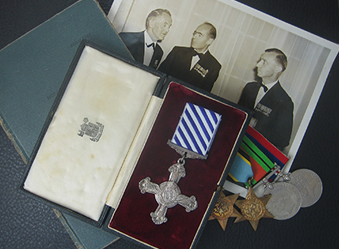
DISTINGUISHED FLYING CROSS, G.VI.R., REVERSE OFFICIALLY DATED 1944, IN ROYAL MINT CASE OF ISSUE, 1939-45 STAR, AIR CREW EUROPE STAR; DEFENCE AND WAR MEDALS 1939-45. WITH RECIPIENTS OBSERVER'S AND AIR GUNNER'S FLYING LOG BOOK
D.F.C. London Gazette 30 June 1944. James Sidney Watson, Flying Officer, 146647. Operational Air Bomber, No. 617 Squadron. The Recommendation reads:
“F/O Watson has completed 41 operational sorties as an Air Bomber. He has taken part in many attacks against such heavily defended targets as Hamburg, Berlin, Essen, Duisburg and Kiel. Moreover, he has carried out two low level missions of a special nature. He has infused into his work an enthusiasm and keenness which it would be difficult to equal and in consequence he has an exemplary record of achievement to his credit. In addition to numerous aiming point photographs which he has brought back he has in recent weeks, when engaged in high level precision bombing, attained a magnificent standard of efficiency. During the attack on the Powder Factory at Bergerac his aircraft was detailed to carry out an attack on its own against the ammunition dump. F/O Watson ‘s outstanding map-reading and bomb aiming enabled him to score a direct hit with the result that a very large part of the dump was completely destroyed.
This Officer’s great gallantry and devotion to duty, often in the face of extremely heavy opposition, call for the highest praise and he is therefore strongly recommended for the award of the D.F.C.”
James Sidney Watson was born in Moorthorpe, South Elmsall in 1917 and after school worked in the laboratory at Frickley Colliery. At the outbreak of the Second War, his job was classed as being a reserved occupation and was exempt from conscription. Despite this, in 1941, he volunteered for service in the Royal Engineers but this was refused because of his job in the mining industry. Determined, he tried again, and was successful in enlisting as aircrew in the RAF. After 22 weeks training, he qualified as an Air Bomber on 31 July 1942 and was posted to 20 O.T.U. Lossiemouth on 1 August. Initially training on Wellington’s, in November 1942, himself and crew were posted to 1658 H.C.U. Riccall for conversion to Halifax bombers and on the 17 November 1942, he joined the crew of W/O Bernard (Bunny) Clayton. Clayton that time serving as a training instructor was an experienced pilot who had completed 31 operations on Wellington’s up to this date and by wars end would be recognised as one of the most skilful pilots in Bomber Command. See the following:
Watson was Commissioned Flying Officer on 21 November 1942 and the following day Clayton’s crew were posted to 51 Halifax Squadron based at Snaith. On 15 January 1943, they took part in their first operation, an attack on the U-boat pens at Lorient, attacking the same target 8 days later. Over the following 3 months, Watson completed 17 operation sorties with Clayton, bombing many heavily defended targets, including; Hamburg, Wilhelmshaven, Essen, Berlin, Nurnberg, Munich, Stuttgart, Duissberg, St Nazaire, Keil, Frankfurt and Plzen, before Clayton left for a second spell as a training instructor. Clayton would be awarded the D.F.C. on 20 April, followed by the C.G.M. in June. Watson and crew continued their tour with a number of different pilots, completing a further 5 sorties; Stettin, Duisberg, Kattegat, Essen and Dortmand, before a period of leave in late May/June. With two tours completed and the C.G.M. and D.F.C. to his name, in late June 1943, Clayton was invited to join the elite 617 squadron, who were seeking highly experienced crews to replace those lost during the ‘Dams’ raids. He then travelled over to 51 Squadron and persuaded all six of his old crew to accompany him, including Watson, who had been promoted to Pilot Officer 21 May. Joining 617 squadron on 2 July, Clayton’s crew began training in methods of low flying and precision bombing with Lancaster’s, taking part in their first raid on 15 July 1943, Operation to Aquata-Scrivia (Italy), where Watson notes in his logbook……………….
SEE PDF FOR FULL WRITE UP
Watson’s logbook covers all Watson’s flights, his operational sorties numbered. It contains the signatures of Wing Commander G.L. Cheshire V.C., Clayton and other well-known 617 Squadron Commanders. It also has a couple of photographs glued to pages taken during the bombing of the Gnome & Rhone Factory at Limoges on 8 February 1944 , one very close up of an explosion marking over buildings, labelled to the reverse ‘Limoges W/C Cheshire marking’ Additionally, the group includes an original 22 x 16cm post war photograph of Watson with Group Captain G.L. Cheshire V.C., D.S.O., 2 bars, D.F.C. and Wing Commander J.B. Tait D.S.O., 3 bars, D.F.C., bar.
Medals in NEF. When originally purchased, the medals and post war photo were framed and the suspender bar from D.F.C. removed. Sold with a quantity of copied research.